Practical
Perspectives
Dan MacLeod
www.danmacleod.com
June 10, 2002
The term "ergonomics" might sound hard — and indeed it is a funny word
— and it has a reputation for involving expensive products. Furthermore, it sounds
like a new field of study, maybe one that is a bit too far-fetched for the hard realities
of modern business life. But it’s not necessarily so.
It Doesn’t Have to Be Hard
For almost every aspect of ergonomics, we can address the issues on two levels: (1) as
a subject for sophisticated science and (2) as a matter of common sense. Both are equally
important, but the latter takes more priority in most workplaces.
Sophisticated Science
On every issue, we can apply the scientific method. Researchers can conduct rigorous
studies, measure human attributes and build mathematical models. There are topics such as
"biomechanics" (studying the human body strictly as a mechanical system) and
"anthropometry" (measurement of humans) that require special training and
experience.
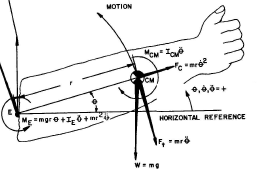 |
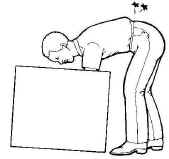 |
| Some things are hard . . . |
but mostly, it doesn't
take a rocket scientist . . . |
Common Sense
But it doesn’t always have to be that complicated. Much of ergonomics can be
intuitive, and ordinary people can provide many ideas about improving the tools,
equipment, and tasks, particularly if they receive training in basic principles.
There’s an ergonomist in every one of us. We all have certain inclinations to
modify our surroundings to fit us.
It Doesn’t
Have to Be Expensive
The expense of applying ergonomics can fall within a wide range. Some things are
expensive, although they usually pay for themselves in the long run. But many changes can
be made with little or no cost.
Expensive Long Term Investments
There are times when new capital-intensive equipment may be required or new facilities
built. Elaborate studies may be needed. A long process of design may be necessary. The
resulting improvements may still have a positive financial return, but the changes may
demand a large initial investment.
For example, improving the design of an airplane cockpit may not be cheap, either to
determine what types of changes might be made, or to implement them. However, it does have
a clear payback in helping pilots fly safely.
 |
 |
Some things are
expensive . . . |
but many things aren't. |
Low Cost
But improvements do not always need to be expensive. It is often surprising what can be
done for low cost by using a little imagination. Some companies estimate that there are 20
low cost fixes for every one that takes some investment.
As an example of a quick fix, this computer monitor has been raised by placing it on
top of a thick book. Awkward heights can often be made better by such simple measures.
Itís Not
Necessarily New
Sometimes it seems like ergonomics is all brand new, because we may have heard the term
for the first time in recent years, or because we see unconventional products available on
the market.
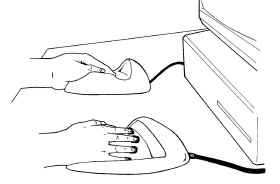 |
An alternative to the keyboard — far-fetched? |
Consequently, it is possible to get the impression that
ergonomics is not quite ready for the here and now. Some people might even have the notion
that it might be best to wait a while to see if ergonomics is just a passing fad.
But this isn’t quite right; in many ways, ergonomics is nothing new. In a certain
sense, humans have been doing ergonomics for 40,000 years.
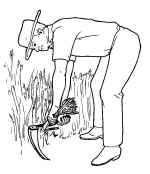 |
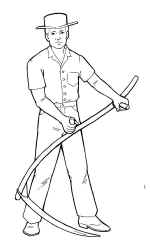 |
A centuries-old safety and
efficiency problem. |
A 19th-century ergonomic
device;
safer and more efficient. |
A good example is a great ergonomic device invented in the 19th Century
— the long-handled scythe. Note the ergonomic features of the two-handed scythe
compared to a one-handed sickle.
You can work upright, keeping the natural curves of the lower back; the grips move up
and down to adjust for the farmer’s height; the grips can be angled to keep the
wrists in their neutral postures; and the very shape of the scythe takes advantage of the
larger muscles and mechanical structure of the upper torso.
And the bottom line is well known. The ergonomic device is clearly easier on the human
and much more productive than the non-ergonomic device. (And the contraption that Mr.
McCormick invented was even better.)
The Big Difference Between Old and New
There is a difference, however, between old-fashioned and modern ergonomics.
Old-fashioned ergonomics was haphazard, a process of trial and error through the years.
Modern ergonomics has the advantage of the scientific method and being systematic. Today
we can measure, and there are analytic techniques and a database of knowledge. The promise
of modern ergonomics is that if we systematically evaluate every task that we do, we can
systematically develop equivalents of the two-handed scythe.
|
